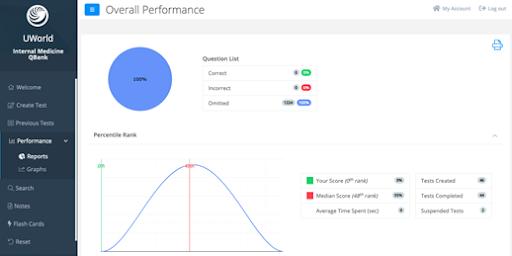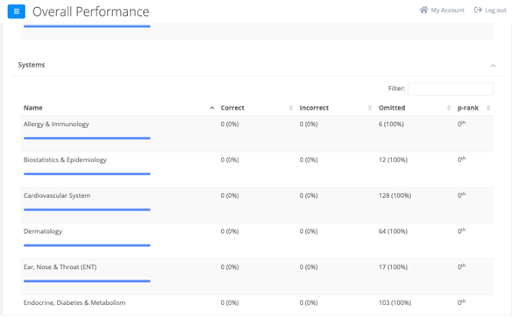Neelam Mistry, MD.
An age-old question comes up every year as thousands of physicians start their journey studying for the ABIM internal medicine boards: Which question bank (Qbank) should I choose? This is a good question because no two Qbanks are exactly alike, no matter which exam you are studying for. With different styles of questions and explanations, in this post, we will be going over the UWorld ABIM Internal Medicine boards Qbank. We’ll be taking a close look at the pros and cons of the UWorld Qbank by examining the user interface, question style and format, links to resources, and other features you want to be aware of when making an informed decision on which resource to use. So, let’s get to it!
Likeness to ABIM Exam
On the ABIM website, you can find a test simulator function to get a good idea of how the real ABIM exam will look. Based on this tool, you can feel confident that UWorld has a great user interface that models the ABIM exam. The UWorld interface also provides the ability to cross out answers, highlight, take notes, and access a calculator, which can be helpful for retaining information while studying.

Content Distribution
The ABIM Exam Blueprint published by the ABIM and available to the public displays the approximate percentages for the different subject areas covered on the exam (see below). Although there may be small variations on your specific exam, this guide is accepted as the most accurate indicator of what to expect to see on test day.

UWorld’s questions approximate ABIM percentages for the most part (within 3% of the percentages outlined in the ABIM Blueprint). The exceptions to this are the Hematology/Oncology questions (7% of the total questions on UWorld vs ~12% on ABIM’s Blueprint) and Nervous System questions (~8% on UWorld vs 4% on ABIM’s Blueprint).
Question Style and Format
Now let’s get into UWorld ABIM question difficulty, length, and quality of explanations.
UWorld questions are slightly more difficult than those on the boards, but that’s certainly better than having them be too easy. On ABIM boards, the information you need is generally given to you in the question, so there isn’t a lot of filling in the blanks like there is in clinical practice. For UWorld, on the other hand, some questions are more vague, and you sometimes need to make assumptions and read between the lines to get to the correct answer. Again, this has its pluses but can have a few minuses. The plus is that the UWorld Qbank really makes you notice details and know your content to be able to answer the vaguer questions. The downside is that, sometimes, it seems “unfair” to have to make certain assumptions, which is not how it will be on the actual boards. In terms of question length, many of the UWorld paragraphs that precede the question are longer than those on the boards. So, if it takes you slightly longer to get through a UWorld question block than the time you would be allotted on the ABIM exam, don’t worry too much.
Where UWorld really excels in this category is the explanations for the answer choices. UWorld has in-depth explanations with helpful charts and diagrams for each question in the ABIM Qbank. If you do multiple GI questions in a row, for example, the same charts and graphs will come up in the similar questions so that you can thoroughly review the content. Also, colorful illustrations demonstrate the concepts you are reviewing, making good memorization aids. The explanations also really hit on the “why” aspect of the question breakdown, which is great for gaining a deeper understanding of different concepts. You can also find links to references at the bottom of each question, including a summary statement at the end of the explanations for supplemental reading. Although UWorld doesn’t have books, the explanation paragraphs with illustrations, charts, and graphs provide a great framework for answering similar questions in the future.
On that note, we want to touch on one disadvantage of UWorld compared to some other ABIM Qbanks out there: no accompanying books. If you are someone who really absorbs content through reading and were looking forward to the MKSAP books, you might be a bit disappointed to know that, as of now, no book accompanies the UWorld ABIM Qbank. However, reading content does not fit everyone’s study style. Many of my students find it difficult to read chapters in a book after spending 12+ hours at work. So again, as we said in the previous paragraph, UWorld’s Qbank does provide great explanations for right/wrong answers if supplementing with reading doesn’t fit your study style.
Metrics and Interface
UWorld’s Qbank has very helpful individual performance data. It is very easy to see how many questions you have left, what percentage you got correct, and more.
There are currently over 1275 questions in the UWorld QBank. When you log in, there is a Performance page that acts as a dashboard. You can see your progress on how many questions you have completed. This page also features a bell curve of where your scores stand compared to others using the ABIM UWorld QBank.

Scrolling down farther, you can see scores for specific practice areas. Although many residency programs are inpatient-heavy when it comes to clinical time, a large portion of the ABIM internal medicine exam is focused on outpatient medicine and emergency room care. As such, you can see the breakdown of how you do on questions based on different practice settings to see if there is an area that deserves more attention when you study.

If you scroll even farther down the page, your correct and incorrect answers are further funneled into subject areas. There, you can sort by the headers: % Correct, % Incorrect, and p-rank (percentile rank, or where you fall compared to others). Once you answer at least half of the Qbank, this section becomes very helpful because you can start seeing patterns/trends based on your own correct/incorrect percentages and your p-rank. This can also help you focus on areas where you’d like to see improvements.

Cost and Duration of Qbank
UWorld’s ABIM Qbank subscription ranges from $399 for 3 months at minimum to $729 for 2 years of access, with 2 options in between. To provide some context, these prices are midrange compared to other available ABIM Qbanks available.
How Does UWorld Stack up to MKSAP, Another Popular ABIM Qbank?
ACP’s MKSAP is another popular choice for ABIM board studying. MKSAP questions are slightly easier, with little to no reading between the lines, which may more closely resemble the ABIM exam. However, there are fewer ways to look at metrics, and MKSAP’s website is less user friendly compared to UWorld’s. In addition, the diagrams/charts are not as helpful (mostly lists).
As mentioned previously, the benefit of MKSAP is that you get the books to learn content that isn’t familiar, in addition to the questions. This is something to keep in mind if reading is important to you. MKSAP Complete, which includes print books and online content, comes in at $699 for members ($989 for nonmembers, $539 for residents/fellows), and you keep it for life.
Conclusion
The UWorld Qbank is a well-curated and easy-to-use resource for studying and includes thorough explanations and good coverage of subject area content. Although UWorld does not have supplemental reading, it does provide links to resources at the end of each question, as well as a summary statement. In the end, we did not find anything in our review of the UWorld ABIM Qbank that was not up to standard with other great ABIM Qbanks. In fact, if you used UWorld for your USMLE studying and found it helpful, you will likely love the UWorld ABIM Qbank too. To succeed on ABIM boards, you will need to put in the necessary time and effort, and it is our view that UWorld can help you achieve that success.
Finally, if you would like expert help integrating the UWorld ABIM Qbank into your ABIM study schedule or need further assistance studying for your exam, you can contact an Elite Medical Prep ABIM tutor, who would be happy to help.




